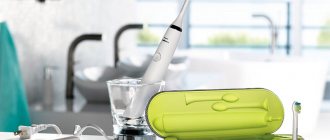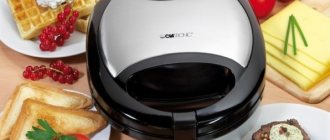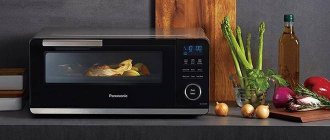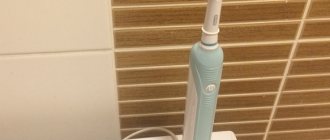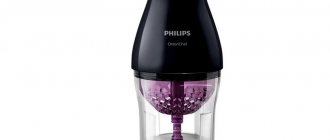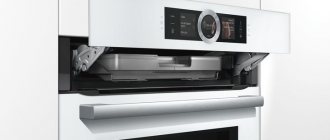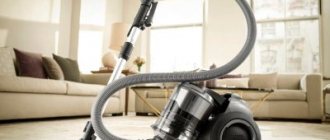According to users who have tried brushing their teeth with an electric brush, they no longer want to go back to a manual one. In addition, many dentists advise choosing electric options that clean and polish teeth more thoroughly and correctly. We offer for consideration the TOP 10 best Oral-B brushes for 2021. The review included models with different functions and capabilities, as well as children's models.
Oral-B Expert
A battery-powered toothbrush with a standard round brush head. Has one operating mode. Makes 9600 directed movements per minute. A light indicates the degree of wear of the bristles.
Advantages:
- nozzles can be changed;
- cleans well, incl. in crevices;
- does not injure the gums;
- The batteries last a long time;
- the handle is rubberized, non-slip;
- low price.
Flaws:
- The battery compartment cover is not sealed;
- For some customers, the lid is difficult to remove;
- there is no pressure sensor and other important functions;
- small area of action;
- nozzles are expensive;
- There are cases of breakdowns after six months, but there are also reviews of work for more than a year without complaints.
See also –
Types of electric toothbrushes
How to choose an electric toothbrush?
Keep in mind! When choosing a model, you should focus on these parameters:
- For a child . Sometimes it is difficult to explain to a child why he should do such a boring task as brushing his teeth every morning. You can get involved in the process by using a game element. Therefore, devices for children are produced in bright colors or with drawings of their favorite cartoon characters. The more interesting the gadget seems, the faster the baby will learn oral hygiene.
- Nozzles . In most cases, a standard nozzle is sufficient for daily use. If the user has sensitive enamel or needs whitening, then you should choose an option with additional attachments that will help cope with the task. Such devices are more expensive, but they immediately cover all needs.
- Pressure sensor . An important element that will help avoid accidental injury to the gums or tooth enamel. It monitors the force with which the fibers press on the surface being cleaned. If the pressure is too strong, the sensor automatically reduces the speed of the device or sends a sound signal to the owner.
- Timer . The presence of a timer will allow you to accurately determine that the cleaning of the oral cavity takes place no less than recommended by experts. Most models are configured to work for two minutes with a signal every 30 seconds so that the user can move on to processing a new area in time.
- Oscillation frequency . Depending on the frequency of movements performed, all devices are divided into three types: subsonic (up to 10 thousand movements per minute), sonic (10-40 thousand movements per minute) and ultrasonic (up to 100 thousand movements per minute). The lower the speed of movement, the more gentle the device is on the teeth. Therefore, ultrasound options are not recommended for children.
Oral-B Vitality 3D White Luxe
Tops the rating of brushes that run on batteries. It is designed for battery life of 28 minutes, charging takes 16 hours. Includes one round nozzle. Revolutions 7600 per minute. It works at one speed and has a whitening mode. Equipped with a timer. There is a notification about the charge level and the need to replace the nozzle. Comes with a storage stand.
Advantages:
- comfortable shape;
- cleans well, removes stone, massages;
- the body is not afraid of moisture;
- works for a long time on one charge;
- does not cause injury to gums;
- cheap.
Flaws:
- not a stable base;
- inconvenient to clean between teeth;
- no place to store attachments;
- buzzes loudly;
- after a year and a half of operation, it holds a charge less;
- high cost of nozzles;
- The timer is fixed, parameters cannot be set, which, according to users, is not very convenient.
See also –
Braun Oral-B Genius 9000 electric toothbrush review
Which brush is better
Oral-B and Philips offer a wide selection of brushes, from affordable simple models with one operating mode to more advanced ones with different configurations and technical capabilities (pressure sensors, statistics collection, synchronization with the application, etc.).
To better understand the difference between the brushes of these two brands, consider two brushes from the mid-price category - Oral-B Smart 4 4000 and Philips Sonicare ProtectiveClean 4300 HX6806/04.
Work technology
Oral B brushes have bristles that rotate and rotate, and the round head covers each tooth individually. This brushing technique allows the bristles to penetrate deep between the teeth, removing up to 100% more plaque compared to a regular brush.
Reciprocating motion is a 2D technology. When pulsating movements are added to them, this is already 3D technology - an even more advanced level of cleaning. Oral-B Smart 4 4000 uses 3D technology and makes 40,000 pulsating and 8,800 reciprocating movements per minute.
Philips Sonicare ProtectiveClean 4300, like all the company's brushes, uses patented SoniCare technology. The bristles make 31,000 sweeping movements per minute. Sonicare technology creates a directed flow of liquid in the mouth, which washes the teeth and gums, removing plaque from hard-to-reach places.
In this way, Philips not only reduces the likelihood of errors that reduce the quality and effectiveness of manual brushing, but also makes the toothpaste work more efficiently.
Design and ergonomics
The Oral-B Smart 4 4000 brush looks minimalistic, but at the same time impressive. The comfortable rubberized handle does not slip in your hand. Modern stylish gadget.
Philips Sonicare ProtectiveClean 4300 is also an example of minimalism in design, only with a touch of sophistication. This is achieved due to smooth shapes, interesting shades and a pleasant non-slip surface with imitation stone.
Timer
All Philips brushes have a built-in 2-minute Smartimer timer, and every 30 seconds the brush stops moving for a split second, signaling that it's time to change the brushing area. After 2 minutes it turns off automatically. Even if you’re thinking about something or haven’t fully woken up yet, you definitely won’t have to brush your teeth longer than expected.
Also, almost all Philips brushes (except for the Sonicare CleanCare+ series) are equipped with EasyStart technology, which helps you get used to the brush comfortably. The intensity of cleaning gradually increases over the first 14 days.
The Oral-B brush also has a built-in timer for 2 minutes at 30-second intervals. After two minutes it does not turn off and continues to work, unlike Philips, which is less convenient.
Oral-B has no analogue to EasyStart.
Nozzles included
The Oral-B brush comes with 2 Cross Action attachments - angled bristles surround each tooth, removing more plaque even from hard-to-reach areas of the mouth. The brush fits all Oral-B brush heads. Oral-B brush heads have medium-hard bristles.
The Philips brush is equipped with 1 C2 Optimal Plaque Defense brush head. This brush with thick, medium-hard bristles cleans teeth of plaque as effectively as possible. The brush is compatible with all Sonicare brush heads. Laser-curved bristles do not injure gums and tooth enamel. The attachment covers 2 teeth at the same time.
A useful addition to both brush heads are indicator bristles that discolor over time, reminding you that it’s time to replace the brush head. Also, some Philips models have a useful BrushSync feature. When it's time to replace the brush head, the light will light up and the toothbrush will beep.
Shape of bristles
The heads of both brushes have bristles that are specially rounded with a laser at the ends - so they do not harm the gums or scratch the enamel. Both brands use synthetic bristles - this is good, since natural bristles are easily penetrated by pathogenic bacteria, they are not resistant to moisture, dry much longer than artificial ones, and the tips of natural bristles cannot be rounded so that they do not injure the gums.
Pressure meter
For gentle cleansing, the Oral-B model has a pressure sensor. If you press too hard on your teeth while brushing, an indicator on the brush lights up.
For the Philips Sonicare ProtectiveClean 4300 model, a sound signal is heard when pressing.
In general, Oral-B implemented the pressure sensor idea better than Philips. For example, the Oral-B GeniusX 20000N model has a triple pressure sensor, which, when pressed, gives a red light signal on the SmartRing, automatically turns off the pulsation and reduces the speed of rotation of the nozzle.
Operating modes
Modes are a necessary thing, because different cases may require different ones. In addition, it is convenient if several family members use the brush.
The Oral-B model operates in 3 modes.
- Daily brushing
is a standard daily cleaning of the oral cavity. - For sensitive teeth
- delicate mode for sensitive enamel. - Whitening
– intensive lightening and polishing of enamel.
The Philips brush has 1 standard mode with intensity level settings: low and high.
More operating modes start with the ProtectiveClean 4500 HX6829/14 and ProtectiveClean 6100 HX6877/29 models. ProtectiveClean 4500 has two of them.
- Clean
- daily cleaning. - Gum care
- gentle massage of the gums for 1 minute.
ProtectiveClean 4500 has three of them (a White
) with 3 intensity levels for each: low, medium and high.
Since the operating technologies and head shape of the brushes are different, the modes themselves are implemented differently. With Oral-B, you can clearly see the difference between the modes: the intensity and the very nature of the movements are different. With Philips, the difference is not so contrasting: only the frequency of movements changes. There are short pauses in the massage mode.
In general, Oral-B's technology for changing modes is better implemented.
Battery
The Oral-B model has a lithium-ion battery that allows the brush to work for up to 2 weeks without recharging (when brushing 2 times a day for 2 minutes).
The Philips Sonicare ProtectiveClean 4300 also has a lithium-ion battery.
We tested both of these models, and the operating time is slightly different from what the manufacturers claim. The Oral-B brush runs for 82 minutes on a single battery charge in Clean mode—that's enough for about 20 days of use. The Philips brush lasts 110 minutes or approximately 27 days on a single charge.
According to the results of our research, the battery life of the Philips brush is higher.
Battery indicator
Both brushes have a battery charge indicator. This is convenient - a discharged brush will not be a surprise.
Oral-B has 2 indicator lights at the bottom of the case. The top one lights up green when charging is complete. The lower one begins to flash red shortly before the battery is completely discharged.
The Philips brush has one indicator that changes color from green to red when it's time to recharge the brush.
Applications
To make oral care easier, both brands have released special apps that control the brushing process. They also create a list of recommendations that suits you, adjusting the time, pressure and thoroughness of cleansing your teeth and gums.
Oral-B app
Oral-B has created an app available for Bluetooth-enabled brushes - GeniusX 20000N, Smart 6 6000N, Smart 4 4000N and Smart 4 4000. The main purpose of the app is to help you care for your oral cavity according to the recommendations of your dentists.
It can:
- Recognize your brushing style
using a motion sensor and make recommendations to improve it. - Set up individual
work parameters according to the dentist’s advice. - Add an element of play to your daily routine
. Augmented reality filters help you stay motivated and strive for better results by rewarding your achievements with new funny photo filters.
The application also collects all statistics
about brushing your teeth! Time, force of impact, quality of cleansing, and so on. According to Oral-B, brushing your teeth with an app can reduce plaque by 73% in just 2 weeks.
Philips app
The Philips Sonicare ProtectiveClean 4300 model does not connect to the application. But for more advanced models (Diamond Clean, Expert Clean, For Kids series) this is possible. Using the Philips app while cleaning you will receive:
- Recommendations
. Perhaps you are not brushing some teeth thoroughly enough - or, conversely, you are too zealous with it. The application will analyze all your actions and adjust them. - The correct position sensor
will tell you whether you are holding the brush correctly. Available only on DiamondClean Smart and FlexCare Platinum Connected. - Progress report
. A complete weekly report with recommendations to improve your oral care.
Oral-B Pro 500 CrossAction
Model with a round nozzle with one operating mode. Provides 8800 directed movements per minute, 20000 pulsations. There is a base for charging and storage. There is a notification about the charge level and the degree of wear. A special sensor indicates the force of pressure on the teeth. Equipped with a timer.
Advantages:
- build quality;
- ergonomic;
- good cleaning;
- gums are not injured or bleed;
- protected from moisture;
- saving on toothpaste;
- teeth stay clean and fresh longer;
Flaws:
- it takes a long time to charge (days) for long-term operation;
- expensive attachments;
- there is no notification about the pressure force (some users say that it is expressed in a change in the degree of buzzing);
- not everyone likes vibration during operation;
- The main nozzle is hard for sensitive gums;
- one mode;
- no carrying case;
- noise during operation.
See also –
Electric toothbrush Oral-B Precision Clean 700/D16.513.UX
Revolutionary teeth cleaning technologies
Over the next decades, the company developed and improved technology. The first toothbrush appeared, combining a brush and an irrigator. In 1998, a revolutionary model appeared on the market - an electric brush with 3D cleaning technology. She affected the teeth simultaneously using reciprocating and pulsating movements. The movement of the cleaning head in different directions made it possible to remove the most difficult plaque as efficiently as possible.
In new models, the manufacturer has improved this technology, increased the number of pulsations, and added a built-in timer. In 2007, the Oral-B Triumph brush appeared with a “smart” navigator, the display of which showed the selected mode, cleaning duration, charge level, and reminded that it was time to change the nozzle.
Oral-B Kids Mickey Mouse
A regular round brush for children with a matching design. Operates at one speed (5600 movements per minute). Has a timer. There is a base for recharging and storage.
Advantages:
- beautiful bright design for a child;
- children brush their teeth without a reminder from adults;
- cleans and polishes well;
- music timer;
- long battery life;
- comfortable.
Flaws:
- more expensive than similar brushes for adults (due to design);
- the bristles are hard, it is better to change them immediately;
- buzzing sound;
- there are cases of breakdowns after six months;
- music is hard to hear;
- not stable without a stand.
See also –
Children's electric toothbrush Oral-B Kids Vitality
How much does it cost to maintain brushes like this?
Heads are one of the main elements of an electric toothbrush. It is recommended to change them every 3 months.
For the Oral-B Smart 4 4000 model, a package of two attachments will cost approximately 800 to 1000 rubles. The price depends on the type of nozzles. A package of two nozzles for the Philips Sonicare ProtectiveClean 4300 model will cost from 1,500 to 3,000 rubles, depending on the purpose of the nozzles.
Both brands produce several types of attachments: for daily cleaning, for sensitive teeth and gums, for tongue cleaning, whitening, gum massage, etc.
Oral-B Stages Power Wheelbarrows D12.513K
More powerful compared to the previous one (rpm 7600 per minute). Battery life is 30 minutes (charge 5 hours). Has a timer so your child knows how long to brush their teeth. Indicates the wear level of the bristles.
Advantages:
- bright children's design;
- comfortable handle;
- cleans well and carefully;
- works autonomously for a long time;
- waterproof.
Flaws:
- the timer reports not with sound, but with a buzzing sound and continues to work (does not turn off);
- no charging indicator;
- no pressure sensor.
See also -
Healthy teeth for children and adults with a set of electric toothbrushes Oral-B Family Edition
Revyline RL 010
Leader of my rating. In its price range, this is undoubtedly the best model. Three body colors to choose from - white, black and pink. The electric brush creates 38,000 pulsations per minute. It is equipped with three standard attachments and operates in 5 modes: cleaning, whitening, polishing, gum massage, and for sensitive teeth. For each program you can choose one of three intensity levels. It runs on a battery that takes 14–18 hours to fully charge. An indicator indicates a decrease in charge. The set includes a stand for the brush and attachments, as well as a travel case.
Advantages:
- Stylish look.
- Several attachments with different designations (suitable for the whole family or as spare ones).
- Holds a charge for a long time.
- Convenient travel case.
- Fits comfortably in the hand.
Flaws:
- The power button is inconveniently located. You may accidentally change the mode while cleaning.
- There are cases of incomplete packaging (no charging adapter or stand for attachments).
The price of Revyline RL 010 is approximately 3,200 rubles. If we compare it with the Oral-B Pro 7000, which we will look at next, the RL 010 does not come with different attachments, operates in fewer modes and does not communicate with the application. But, judging by the reviews, such functions are not in great demand, and the price is half as much. The electric brush does an excellent job of cleaning, has good characteristics and positive reviews. 94% of buyers recommend it for use. And if you have a limited budget and are looking for something cheaper, then the Revyline RL030 electric brush would be an excellent option. Its price is only 890 rubles.
Oral-B Vitality Sensitive
An electric brush with a round nozzle, made in white-blue or light blue. It operates at one speed and has a delicate cleaning mode. Notifies you when it is necessary to charge or replace the attachment. Speed 7600 rpm. Works on a timer.
Advantages:
- high quality handle;
- good sedum and polishing;
- does not injure the gums;
- Changing attachments is easy, they are installed steadily and do not play;
- a large selection of consumables (it’s easy to choose the best option on the advice of your dentist);
- Convenient storage base.
Flaws:
- uninformative timer, you need to get used to it;
- expensive consumables;
- The battery lasts for a week;
- It buzzes and vibrates a lot.
See also –
Oral b genius pro 8000: stylish design and 3D cleaning
Choosing the right brush: what to look for
First of all, let's talk about how to approach the issue of choice correctly. Below we will make a small rating of the most interesting models.
So, no matter what brand you decide to buy, take a closer look at this:
Power supply
Electric brushes can be powered by a rechargeable battery or a simple AA or AAA battery. The former are much more expensive, but purchasing the latter is only an apparent saving. Each battery costs money, and they will have to be changed quite often.
Type of movement of the working head
The cheapest brushes use 1-D technology. This means that the nozzle can only move in a circle and in one direction. Reviews from owners of such accessories tell us that such brushes are not much more effective than regular ones.
It is better to choose a model that has at least two directions of movement (2-D). The ability to perform reciprocating movements significantly improves the operation of the device.
The best electric toothbrush is made with 3-D vibration technology. That is, it not only “walks” back and forth, but can pulsate. This allows you to most effectively remove pigment and bacterial plaque.
Number of operating modes
Even the cheapest electric toothbrush will have at least one mode: “everyday use”. By and large, this is enough. But if you are willing to overpay for options, you will be interested in the following modes:
- deep cleansing;
- gum care;
- bleaching;
- tongue cleansing;
- program for particularly sensitive teeth.
The best electric toothbrushes have all of these modes and more.
True, all this costs much more. See also -
Which oral irrigator is better to choose: 2021 rating
Replaceable attachments
As a rule, budget models have only one nozzle. An additional set of others can be purchased separately based on the number of desired functions or the number of family members. It is good to purchase cleaning “heads” that are already marked in various ways, for example, with multi-colored rings. Otherwise, in order for household members not to confuse their “head” with someone else’s, they will have to be marked themselves.
Control systems
The best electric toothbrushes of 2021 are equipped with built-in sensors that allow you to monitor the process. Some models are able to monitor the pressing force of the working “head”. This helps prevent excessive wear of tooth enamel. Others offer a special timer that shows exactly how long a particular area needs to be cleaned.
Oral-B Professional Care 800
Electric brush with a regular nozzle. I included this review because of the presence of additional attachments: Precision Clean and Sensitive. Charges in 16 hours, can be charged 14 times in 2 minutes. Works in one mode. 8800 revolutions and 20000 pulsations per minute are provided. There is a timer. Equipped with the ability to determine the degree of pressure. There is information about the charge level.
Advantages:
- cleans in hard-to-reach places;
- removes stone well;
- suitable for sensitive teeth and gums;
- fits nicely in the hand;
- quality materials.
Flaws:
- inconvenient timer;
- unstable stand;
- strong noise and vibration;
- long charging time;
- the plastic is not very nice;
- no case.
Children's
Oral-B Junior
An excellent option for teaching the use of a brush.
The Oral-B Junior battery charge is enough for continuous operation for 28 minutes.
After the device is discharged, its further full charging time is 24 hours. The nozzle makes 20 thousand pulsations and 8.8 thousand movements in one minute.
Thus, the device effectively removes all contaminants.
There is a two-minute timer that signals every 30 seconds that it is time to move on to the next cleaning area.
The degree of pressure on the teeth and gums is controlled using a pressure sensor.
Specifications:
- one nozzle;
- one operating modes;
- battery use time - 28 minutes;
- Full charge time - 24 hours;
- timer;
- stored on a special stand;
- suitable for children from 6 years old;
Advantages
- Perfect for teaching a child to brush their teeth;
- easy to use;
- presence of a timer;
- high-quality work of the nozzle;
- There is a signal indicating that charging is complete.
Flaws
- only one working nozzle;
- takes a long time to charge.
Oral-B Smart 4 4900
A set of two smart brushes with three operating modes.
The Oral-B Smart 4 4900 set includes two stylish smart brushes. They have a timer for a maximum of two minutes.
There are three special modes aimed at whitening, caring for sensitive teeth and everyday use.
The set contains two attachments and a container for storing gadgets. Removal of hard-to-reach plaque is achieved using 3D technology.
The devices have a Bluetooth module for connecting to a special application on a smartphone. It provides advice on the best care for your teeth and mouth.
Specifications:
- two nozzles;
- three operating modes;
- battery use time - 28 minutes;
- Full charge time - 14 hours;
- timer;
- stored on a special stand with holders for additional attachments;
- suitable for children from 3 years old;
Advantages
- timer function;
- three modes for optimal use;
- high-quality cleansing;
- holds a charge well;
- fits comfortably in the hand;
- synchronization with mobile phone.
Flaws
- works noisy.
Oral-B Vitality Kids Frozen (D100.413.2K)
A bright design that will melt the heart of any child.
The Oral-B Vitality Kids Frozen device with a memorable design in the “Frozen” style will awaken in the child the desire to use the device every day.
The set includes four stickers that can be used to create a unique appearance for your device. The device fits comfortably in the hand thanks to the rubberized handle.
Teeth are effectively cleaned because... the device manages to make 7.6 thousand movements per minute. There are two operating modes - standard and gentle.
The gadget is compatible with the Disney MagicTimer application developed by the manufacturer.
Specifications:
- one nozzle;
- two operating modes;
- battery use time - 32 minutes;
- Full charge time - 16 hours;
- timer;
- stored on a special stand;
- suitable for children from 3 years old;
Advantages
- game timer;
- two operating modes;
- thorough cleansing of the oral cavity;
- long battery life;
- comfortable ergonomic handle;
- synchronization with smartphone.
Flaws
- expensive attachments;
- It is impossible to track how much time is left until the end of charging.
Oral-B Stages Power Star Wars D12.513K
A beautiful device for effectively cleaning food residues.
The bright Oral-B Stages Power Star Wars device will attract your baby to daily dental care. The device has a waterproof and shockproof housing.
The nozzle does its job thoroughly; the head makes up to 7.6 thousand movements per minute.
Its design is made in such a way that the fibers penetrate into the most inaccessible places.
The device is easily activated using a button located in the center of the body.
Operating time without charging is 28 minutes. The device requires only 5 hours to be fully recharged.
Specifications:
- one cleaning head;
- one operating mode;
- battery usage time - 28 minutes;
- Full charge time - 5 hours;
- timer;
- stored on a special stand;
- suitable for children from 3 years old;
Advantages
- two minute timer;
- high-quality cleaning of the oral cavity;
- fast charging;
- convenient durable case;
- ease of use;
- synchronizes with the application on your smartphone.
Flaws
- only one nozzle;
- makes noise while cleaning.
Oral-B Pro 2500
The model can be presented in black and pink. Comes with one nozzle. Has two modes, including a massager. Notifies about the need to charge, about the wear of the bristles, about the degree of pressure on the teeth. Has a timer. Comes with a case.
Advantages:
- good cleansing;
- there is a massage effect;
- signal about switching to another jaw;
- capacious battery (enough for 2 weeks);
- the ability to choose the right bristles.
Flaws:
- the brush can be installed incorrectly on the base (no explanation);
- takes a long time to charge;
- makes a lot of noise;
- expensive consumables.
Xiaomi Mi Electric Toothbrush
Xiaomi occupies third place in the ranking. The pulsation frequency is less than that of Revyline - 31,000 per minute. It is equipped with one nozzle equipped with a larger number of bristles than conventional brushes. A special feature of the model is a soft start. When turned on for 10 seconds, movements occur slowly to avoid splashing of the paste. Separately, you can use additional functions: 30 seconds for whitening, 10 for gentle cleaning, 10 for cleaning the tongue. The brush remembers the last selected mode. If you apply too much pressure, the indicator will flash and the vibrations will decrease. The model is integrated with an application in which you can set up your personal cleaning regimen, track information about past procedures and select different programs. A highly sensitive sensor integrated into the brush recognizes the speed, duration and areas of cleaning. After which a report on oral health is compiled. Such data can be viewed for past days, weeks, months. The user is also given recommendations regarding the need to change the procedure for better care. The brush can be connected to a temperature and humidity sensor. The handle holder is made of waterproof material and has a special coating that prevents slipping in the hand. The power button is seamless. No moisture will get into the housing through it. The model is powered by a battery, which requires 12 hours to recharge. The set includes a stand.
Advantages:
- The assembly is high quality. There are no gaps or backlashes.
- Fits comfortably in the hand.
- Control via smartphone.
- Cleans efficiently.
- Consumables are available.
Flaws:
- There are cases when, after several months of use, the brush stops charging.
- The vibrations are quite strong and the hum is unpleasant (some users compare it to a burr).
- Discharges faster than indicated by the manufacturer (does not last 72 hours).
Price 2800 rubles. The model has excellent technical equipment, sensors to prevent strong pressure, the ability to configure an individual mode, receive data and recommendations on previous procedures based on the report. Xiaomi is inferior to the review leaders in the number of attachments and pulsation frequency. 91% of users recommend it for purchase.
Oral-B Genius 8900
Set of two brushes. Comes with 3 attachments, including delicate and whitening. Works at 5 speeds. There is a sensitive mode, whitening, massager. Has 12 backlight colors. In addition to the timer, they are equipped with a pressure sensor on the teeth. There is a notification about the charge level and the condition of the bristles. The base allows you to store not only the brush, but also consumables. There is a case for transportation. Has Bluetooth for communication with the Oral-B App. Comes with a smartphone holder.
Advantages:
- removes stone well and polishes;
- it is possible to choose a suitable nozzle;
- comfortable handle;
- thoughtful storage of consumables;
- pressure sensor, timer.
Flaws:
- The battery does not last long;
- long charging time from zero;
- Not everyone is satisfied with the noise level.
Conclusion
Both brands supply their device models with various attachments and accessories, including those for children. Newer and more advanced brushes are synchronized with applications on the phone, controlling the process and quality of cleaning. Also, both models of brushes provide the same high quality of cleaning.
For the rest, we recommend that you proceed from your needs and preferences. If you need a gentler clean (for example, sensitive teeth and gums), choose Philips. Oral-B with reciprocating movements is well suited for combating hard plaque - the rotational movements of the round nozzle have a stronger mechanical effect.
Types of brushes
Depending on the design of the mechanism that sets the bristles in motion, an electric brush can be of three types:
- with a conventional mechanical operating principle;
- sound;
- ultrasonic
Each has both its advantages and disadvantages. Therefore, before purchasing this or that model, you should still consult a dentist.
Electromechanical brushes
In such accessories, the bristles move using a miniature electric motor. The device actually imitates the usual manual cleaning, only in a highly accelerated mode. Brushes in 2-D technology are the closest to “manual” ones.
Such devices effectively clean plaque, have virtually no effect on fillings and greatly reduce the time spent on cleaning. The disadvantages include the following:
- cannot be used during exacerbation of gum disease, since the risk of injury in this case increases many times;
- if used incorrectly, damage to the enamel may occur;
- It is not recommended for use by those who have caries at least in the first stage (white spots on the teeth).
Sonic electric toothbrush
These accessories are designed a little differently. There is a small sound generator inside the case. It forces the bristles to move at a frequency of about 20-30 thousand repetitions per minute. In addition, the dynamic flow of liquid generated by the villi allows you to effectively remove the smallest particles of food from the spaces between the teeth and the gingival sulcus.
Such models do an excellent job with hard-to-reach places in the mouth, remove pigmented plaque and do not at all affect the safety of fillings and crowns. However, such a device must be used correctly. Do not put pressure on the brush, linger in one place for more than 1–2 seconds, or use pastes with a high degree of abrasiveness.
Ultrasonic toothbrush models
Now let's talk about how one of the new products works - an ultrasonic toothbrush. In the middle of such a device there is a special generator. It converts electric current into an ultrasonic wave. In this case, the frequency of movement (oscillation) of the bristles increases to 100 million, and the amplitude decreases. It may seem that the bristles are not moving at all.
An ultrasonic wave is transmitted to dental plaque. Due to the difference in physical properties, this effect is not the same. This leads to plaque and microorganisms simply breaking away from the enamel. Thus, ultrasonic toothbrushes clean the oral cavity efficiently, destroy microorganisms, and effectively act on soft and hard deposits. The procedure time is minimal.
There is one more positive quality. Ultrasound slightly warms up the liquid in the oral cavity, and this facilitates better penetration of the components of the cleaning paste into the tooth tissue.
But all the advantages can instantly turn into disadvantages. Ultrasonic devices negatively affect untreated teeth, destroy fillings and veneers, and can cause exacerbation of gum disease. In addition, such toothbrushes are contraindicated for use by pregnant women and those with a pacemaker. In general, only people with absolutely healthy teeth can use this miracle of technology.


